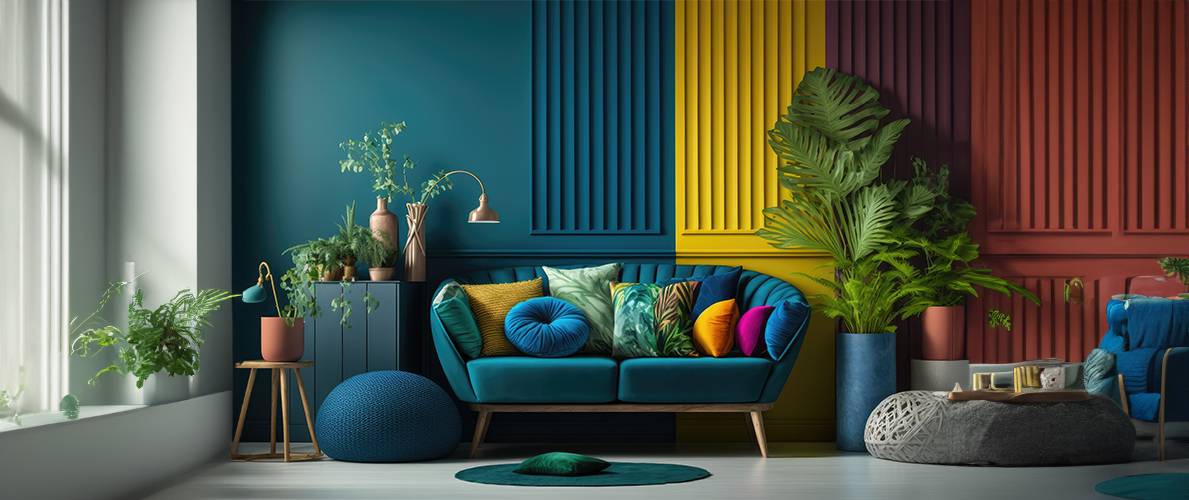Change Your Home With Crucial Principles of Interior Decoration and Appearances
The art of changing your home via the important principles of interior decoration and looks calls for a thoughtful strategy that balances shade, equilibrium, and spatial awareness. By comprehending the influence of color theory and the significance of structure and patterns, one can create rooms that are not only aesthetically attractive yet likewise deeply personal. Achieving this balance includes greater than simple design; it incorporates a calculated arrangement and a keen understanding of exactly how each element engages within a room. As we explore these fundamental concepts, consider how they could redefine your understanding of home and individual expression.
Comprehending Color Theory
Comprehending the principles of shade theory allows developers to create areas that reverberate emotionally with residents while fulfilling functional needs. Each category plays an essential duty in developing harmony within a space.
The emotional impact of shades is profound; warm colors such as reds and oranges evoke energy and warmth, while awesome tones like blues and greens promote calmness and harmony. The usage of complementary colors improves visual passion, creating striking contrasts that can boost a room's charm.
Neutral shades, on the other hand, act as a versatile background, allowing other style components to beam. It is important to think about factors such as lighting and the area's purpose when selecting a color scheme, as these can modify the perception of shades throughout the day.
Inevitably, a well-considered color plan can change a space, cultivating a sense of comfort and design that lines up with the occupants' choices. Proficiency of shade concept is, for that reason, a vital ability for any type of interior developer aiming to create unified and inviting atmospheres.
Accomplishing Balance in Style
Exactly how can designers accomplish a feeling of equilibrium in their areas? Attaining equilibrium in style is fundamental to creating unified insides.
Unbalanced equilibrium, on the other hand, depends on differing elements that still achieve a natural look. This technique enables for more dynamic and casual plans, giving interest while keeping equilibrium. By meticulously choosing varying dimensions, shades, and structures, designers can create an aesthetically compelling space that really feels balanced yet energised.
Radial balance stresses a main focal factor with aspects emitting external. This design is frequently seen in round designs, where furniture and design produce a natural border that attracts the eye inward.
Ultimately, accomplishing equilibrium requires thoughtful consideration of scale, percentage, and the partnerships in between components. miami interior design. By skillfully applying these equilibrium concepts, designers can change spaces into environments that feel both aesthetically pleasing and functionally unified, enhancing the total experience for occupants
Significance of Spatial Awareness

An eager feeling of spatial awareness enables developers to determine centerpieces within an area, assisting the viewer's focus to crucial features while keeping a general feeling of unity. It likewise aids in the strategic placement of illumination, which can dramatically influence the understanding of space and mood. In addition, understanding spatial partnerships makes it possible for the designer to deal with the details demands of citizens, making certain that each location offers its intended objective without jeopardizing aesthetic appeals.
Eventually, spatial recognition is vital for taking full advantage of the capacity of any type of indoor space. By very carefully taking into consideration the interaction in between measurements, format, and feature, designers can create settings that not just meet functional requirements but likewise stimulate a feeling of comfort and charm, improving the total living have a peek here experience.
Incorporating Texture and Patterns
Accepting a diverse series of appearances and patterns can considerably improve the visual and tactile appeal of an indoor space. The tactical usage of various materials-- such as wood, metal, fabric, and stone-- produces depth and passion, making an area feel more inviting and vibrant. For instance, integrating smooth surfaces with rough textures can develop a balance that draws the eye and go now engages the detects.
When incorporating patterns, think about both range and rep. Big patterns can serve as prime focus, while smaller, refined designs can match various other elements without overwhelming the room. Layering patterns, such as pairing floral cushions with striped tosses, includes complexity and a sense of consistency if performed attentively.
It is additionally critical to keep a cohesive shade palette, guaranteeing that textures and patterns collaborate rather than contend for interest. By picking a couple of key appearances and patterns, you can create a merged visual that reflects your individual style while improving the general ambiance of the room. Ultimately, the careful unification of these aspects can change a mundane area into an innovative environment abundant with personality and heat.
Individualizing Your Space
Producing a space that reflects your character is essential to accomplishing an absolutely welcoming setting. Personalization in interior decoration allows you to infuse your special design and rate of interests into your home, transforming it from a simple shelter into a shelter that speaks with who you are. Begin by picking a color combination that reverberates with your emotions-- vibrant colors can energize, while soft tones offer serenity.
Include art work and design that reflect your passions, whether it be traveling, nature, or abstract concepts. Showing personal collections, such as books, pictures, or keepsakes, can stimulate treasured memories and create focal points within a space. Furthermore, take into consideration personalizing useful pieces, like upholstered furnishings, to straighten with your aesthetic choices.

Conclusion
Finally, the transformation of a home with the crucial principles of interior decoration and aesthetics necessitates a thorough understanding of color theory, equilibrium, spatial understanding, texture, and personalization. Each aspect contributes significantly to developing a harmonious and useful living environment - luxury interior design. By thoughtfully integrating these principles, people can enhance the aesthetic charm and psychological vibration of their spaces, ultimately fostering a home that reflects distinct identifications while offering convenience and functionality